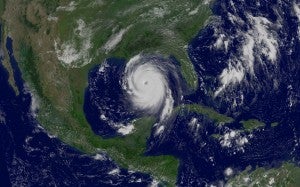Seven Years Later: Hurricane Katrina and MRGO
Seven years ago today, Hurricane Katrina slammed into the coastlines of Louisiana and Mississippi, ripping a path of destruction and shattering the lives of countless coastal residents. Around the world, images of flooding and destruction were burned into the eyes of billions of people as they watched one the costliest, deadliest disasters in American history unfold before them.
Today, seven years have passed, and as we speak, Hurricane Isaac is hovering over the coast. As Katrina continues to affect Louisiana residents in very real ways, countless others continue their work helping those who have suffered.

Hurricane Katrina in the Gulf of Mexico. Credit: GOES 12 Satellite, NASA, NOAA.
Where does the Mississippi River Delta Restoration Campaign fit into the equation? Consider our campaign’s tagline: “reconnecting the river to its delta to protect people, wildlife and jobs.”
The key word here is “protect.”
There are thousands of reasons why we should restore Louisiana’s coastal wetlands. They provide the natural resources on which the state’s economy thrives. They hold some of the world’s most popular game fish and waterfowl. They offer stopover and nesting sites for hundreds of millions of birds.
But they also offer protection.
By absorbing storm surge and acting as horizontal levees, wetlands are a key line of defense against hurricanes. As wetlands disappear, so do the natural defenses for millions of coastal residents, hundreds of billions of dollars in oil and gas infrastructure, and our nation’s most important navigation system.
Louisiana’s communities are the most vital part of this equation — they are the backbone of the region’s culture and economy. With every acre of wetlands that disappears, coastal residents are an acre closer to disaster. For evidence, we look back at Hurricane Katrina and the disaster that unfolded in the Mississippi River Gulf Outlet (MRGO).
MRGO is a channel dug by the Army Corps of Engineers in the 1950s and 1960s as a shorter shipping route from the Gulf of Mexico to New Orleans. It was supposed to save time and money in shipping and navigation, but it turned out to be expensive and underused. In 2006, every ship passing through the channel cost state taxpayers $20,000. What’s more, it destroyed 27,000 acres of vital wetlands and impacted over 600,000 acres of coastal habitat that protects the Greater New Orleans area.
When Hurricane Katrina struck, storm surge from the MRGO breached levees and floodwalls in St. Bernard Parish and New Orleans, flooding homes throughout the areas. The MRGO channel actually acted as a funnel, amplifying storm surge by 20 to 40 percent, resulting in catastrophic flooding in the historic Lower 9th Ward of New Orleans.
Because of the destructive role MRGO played in the Katrina disaster, the U.S. Congress ordered the corps to close the channel in 2006. Earlier this year, a federal court upheld a previous ruling that names the Army Corps of Engineers responsible for negligence in its mismanagement of the MRGO.
Yet despite its closure, MRGO isn’t gone yet. Though the channel is closed to navigation, the ecosystem continues to deteriorate and still needs restoration of critical landscape features that help buffer storm surge and waves.
In 2008, Congress gave the corps a six month deadline to develop a comprehensive closure plan that includes wetlands restoration. Four years later, no plan is complete, and restoration has yet to begin.
The Corps of Engineers is now considering further delaying restoration because of a cost-share dispute with the state of Louisiana. Their current restoration plan also does not include plans for the Violet diversion, which would deliver sustaining fresh water and a small amount of sediment to the Central Wetlands and Biloxi Marshes east of New Orleans. The Violet diversion is critical for the long-term viability of any wetland restoration in the area.
Louisiana needs a plan that mirrors the unprecedented scale of damage done to these coastal habitats and storm buffers. This plan should have been put in place years ago. Further delay on implementation is unacceptable.
The Corps of Engineers is currently accepting comments on its MRGO restoration plan, and Louisiana needs your help. By submitting your own comments to the corps, you can be an additional voice for the communities impacted by Hurricane Katrina and MRGO.
Nothing can undo the damage that was done, but by restoring the area around the MRGO, we can restore wildlife and add one more line of defense for the people of New Orleans and St. Bernard Parish. With another hurricane striking on this 7th anniversary of Katrina, it’s the right thing to do.
Submit comments to the Army Corps of Engineers on MRGO via NWF